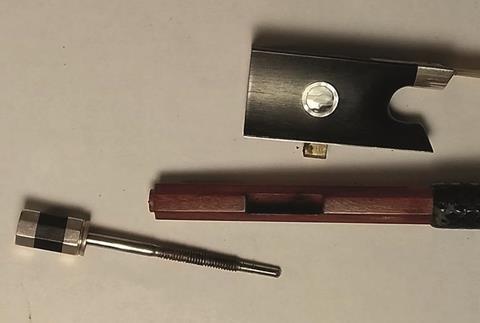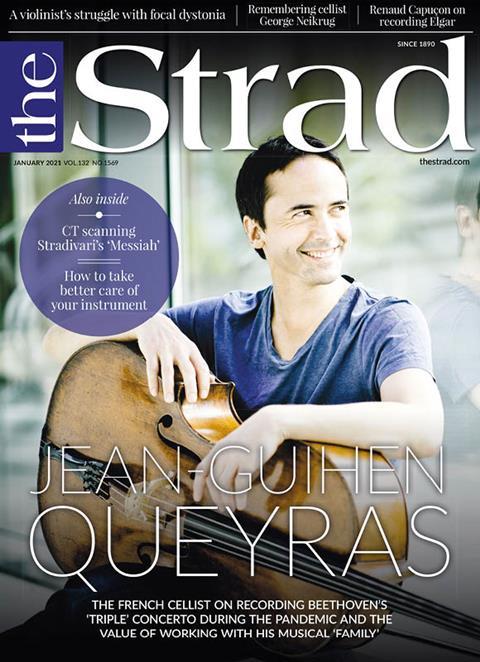Korinthia Klein presents a simple player’s guide to violin maintenance, without encroaching on luthiers’ territory

The following is an extract from an article on instrument care for players in The Strad’s January 2021 issue. To read in full, click here to subscribe and login. The January 2021 digital magazine and print edition are on sale now.
The average player tends to have little understanding about the workings of their bow. I certainly didn’t know much about mine before I learnt how to rehair it. Your bow is half of your instrument, not an accessory, and a good one makes a huge difference. If you’ve never paid much attention to the quality of your bow, it’s worth exploring your options.
The first thing to keep in mind is that a tightened bow is far more likely to break under tension than when it is not, so always loosen it when not in use. The next thing that is important to know is that weather has a big impact on the length of the hair. Horsehair is longer when the air is warm and humid, and shorter when cold and dry.
Tightening and loosening a bow is accomplished by the frog sliding back and forth along the stick when you turn the screw. The length of the mortise that the frog fits into is the total range available for adjusting the length of the hair.
If your bow won’t tighten enough, never keep turning the screw in an attempt to force it to do more. There are actually two main parts to what most players call ‘the screw’. The portion that fits into the stick that screws into the eyelet attached to the frog is the actual ‘screw’, and the ‘button’ is the part you grasp. When you keep turning the screw past the point where there is any mortise left, you start pulling the button off the screw itself.
If the hair is simply too long, sometimes a luthier can shorten it. Often it makes more sense to rehair the bow.
Read: 7 things to remember when buying a bow
Read: Ask the Experts: how to fix a wobbling bow frog
When the hair length is not the issue, two other reasons for a bow not tightening are a failed plug and a failed knot. If the piece inside the frog called the ‘plug’ that is holding that end of the hair in place has shifted or come loose, that can cause the knot to move forward. If the knot holding the hair together itself fails, what looks at first like a bow that won’t tighten turns into hair simply falling out of the bow. Either of these problems means you need a rehair.
Occasionally when a bow won’t tighten it’s because the eyelet is stripped. This feels like the screw turning easily and uselessly when you try to use it in either direction. Often people describe this to me as the screw being stripped, but it’s actually the brass eyelet which the screw fits into that is the part that fails. In this case you’ll need a new eyelet.
When a bow won’t loosen, the hair is too short, and there is no way to go back into the bow to adjust the length the way you can sometimes do when the hair is too long. More often than not, this is related to weather, and factoring in the composition and the quality of the bow is important when deciding whether to get a rehair to fix it.
Where I live in Wisconsin, we sometimes experience shockingly cold snaps in the winter for as long as a week or two, when everyone’s bow hair shrinks up at once. It doesn’t usually make sense to replace the hair, which will then likely be too long once the polar vortex has passed. For inexpensive carbon-fibre bows in my rental programme, I tell concerned customers not to worry about the temporary extra tension since the bows should survive it and be back to normal when the weather levels out. For people with wood bows that could be vulnerable to breakage, I advise them to loosen the screw completely and remove the frog from the bow when not in use during that period.
If your bow won’t loosen and you expect to remain in the environment that made it so for an extended time, get a rehair.
-
This article was published in the January 2021 Jean-Guihen Queyras issue
The French cellist on recording Beethoven’s ‘Triple’ Concerto during the pandemic and the value of working with his musical ‘family’. Explore all the articles in this issue.Explore all the articles in this issue
More from this issue…
- French cellist Jean-Guihen Queyras
- CT scanning Stradivari’s ‘Messiah’
- Remembering cello tutor George Neikrug
- Renaud Capuçon on recording Elgar’s Violin Concerto
- How players can take better care of their instrument
- Playing Tchaikovsky with just two left-hand fingers
Read more playing content here

Topics
Best of 2023: The Strad’s Twelve Days of Lutherie
- 1
- 2
- 3
- 4
- 5
 Currently reading
Currently readingWhat to do if your violin bow won’t tighten or loosen
- 6
- 7
- 8
- 9
- 10
- 11
- 12
- 13























































No comments yet